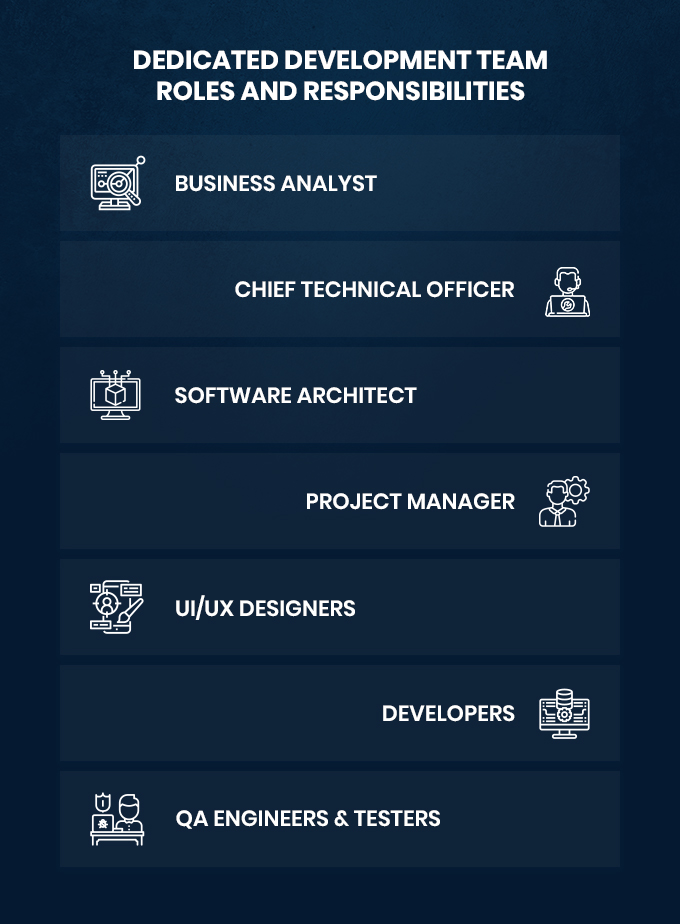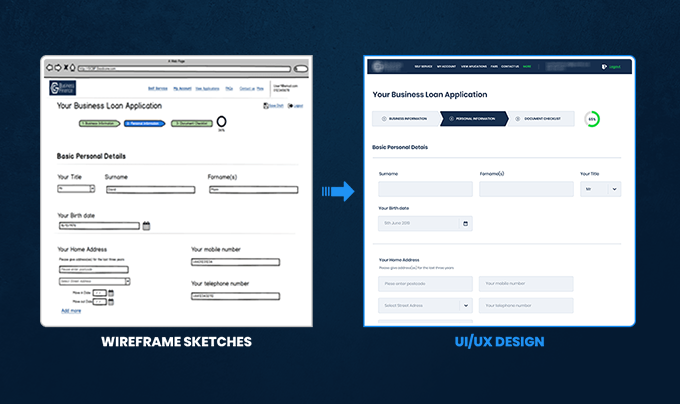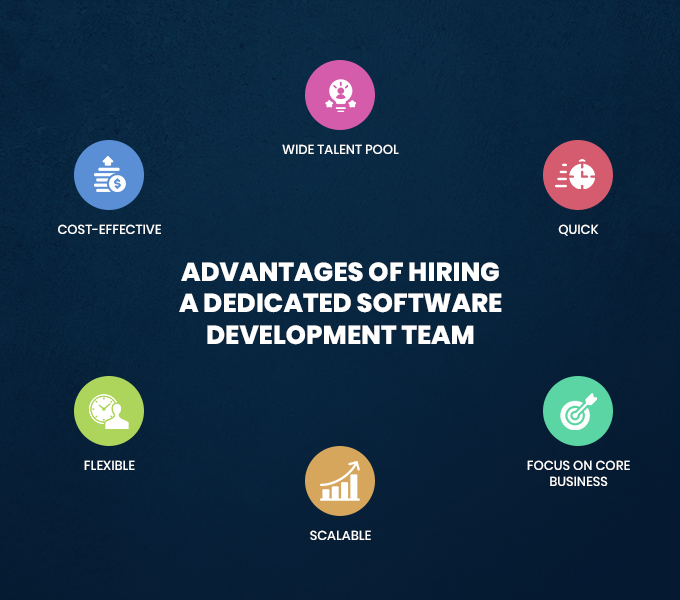As a business whose key operations are not majorly dependent on app development, you may eventually be faced with the critical decision to invest in a custom software application. There are various ways to go about bespoke software development, such as hiring freelance developers or partnering with professional software companies possessing years of experience in the field.
Today, we will talk about one of the most popular models for software development projects: dedicated software development. We will go over the roles that a dedicated team includes, the factors that determine its size and structure, and its benefits for clients like you. However, before we get into those details, let us shed some light on what exactly a dedicated team is.
What Is A Dedicated Software Development Team?
A dedicated software development team is a group of skilled professionals who work on your software development project by remotely collaborating with you. This team is tasked with the responsibility of carrying your project to successful completion within a certain period.
These professionals are employed by a third party (usually a software company) and are not on your organisation’s payroll. You provide all the project details to the software company and request them to assign a certain number of their best resources to you. These resources then dedicatedly work on your project. They take over all tasks related to software development, allowing you to focus on your core business activities.
A professional team to lead your development venture
GoodCore’s talent pool of valuable resources is available at your beck and call. The design and development team we put together for you will focus solely on your project.
Learn More
Dedicated software development is often confused with team augmentation (also known as staff augmentation), but there is a slight difference between the two.
Team augmentation refers to a scenario where the client may have an existing development team and wishes to add to it one or more new roles and staff members. This model is usually adopted to cope with a seasonal or one-off change in demand for a few extra pairs of hands.
Dedicated software development teams are completely standalone groups comprising all the roles deemed necessary for a particular project. They are usually contractually employed by clients for long-term engagements.

Dedicated Software Development Team Structure
To successfully launch a new application, you need to come up with the perfect development team. There are several aspects of deciding on the structure of your dedicated team. Multiple factors need to be kept in mind. Let us address these concerns one at a time.
First, let us go over the various individual roles you may need to fill within your dream team. After that, we will discuss the different factors that might influence your team and its structure as a whole.
Roles and Responsibilities
Certain roles need to be filled when you hire a dedicated software development team. Before you can pick the roles and fill them with suitable resources, you need to understand what each role implies, i.e. what tasks and responsibilities fall under each title.
The following are a few common roles that are part of a typical dedicated team. It is not necessary to have them all on your team. There might be some degree of overlap between certain roles. Each role’s description will help you decide whether or not you need it to fulfil your particular project’s requirements.
Business Analyst
The most important aim of every software product development venture is to meet every single functional and non-functional requirement perfectly. However, the software should not only be completely operational but also meet certain business goals of yours.
A business analyst acts as a bridge between the two sides of any software project: technology and business. They analyse the requirements that you put forward in terms of business growth and advancement. For example, if one of the goals you wish to achieve with your software application is increased efficiency with daily tasks, the business analyst might suggest ways you can use your app to automate your business processes. Thus, they help you address your business needs via technical solutions.
For each aspect of your app, the business analyst will examine and determine whether it is viable for you, the client, (and the end-users) from both technical and business perspectives. Business analysts make sure that you and the development team fully understand each other.
Chief Technical Officer (CTO)
A CTO’s role is highly focused on the technical aspects of the development process. They are deemed the tech leaders of dedicated development teams.
The CTO will guide you regarding critical technological choices that you will be required to make throughout the development process. They may assist you in assessing the practicality, scalability, and financial viability of certain technical solutions, and suggest improvements in development processes along the way. You can also consult a CTO if you are having a hard time choosing the right roles or team members for your project.
A CTO can make or break your entrepreneurship venture.
With our virtual CTO services, you can bring a seasoned chief technology officer aboard your software development team and get the best technical advice that aligns with your business goals.
Explore Now
Software Architect
While this is a highly technical role, it requires a mixture of hard and soft skills. It is expected of software architects to be well-versed in multiple development languages and technologies. As a tech expert, a software architect answers questions such as what development tools and technologies the team will use, which platform(s) the development will take place on, and which technology stack will work best for a particular project. They decide the overall architecture – the technical design – of the software application.
As leaders, software architects need to ensure that the dedicated software development team is meeting certain industry benchmarks. They must also be communicative. They should be able to bring the team back on track if they go off schedule, and guide them if they run into technical problems during development. If the need arises, they should be equipped to handle direct conversations with the client too.
Project Manager
This is one of the most important roles in nearly all dedicated software development teams. As their title suggests, they manage the project in such a way that all development activities go smoothly from the get-go.
The project manager (PM) oversees the project’s progress from start to finish and expertly leads the software development team. They ensure that the project requirements are clearly expressed by the client and thoroughly understood by the development team.
The PM’s job also includes making sure that the project team is sticking to the pre-decided budget, project scope, and delivery timeline, and is dutifully carrying out its assigned tasks. Another key responsibility of a project manager is to conduct regular meetings and act as a coordinator between the client and the development team.
UI & UX Designers
All the roles we have discussed so far deal with project planning, scheduling, budgeting, or other conceptual functions. The roles of UI and UX designers are crucial in that they are the first ones in a dedicated software development team to set the project execution in motion and bear tangible outcomes.
The design phase is critical for any app you build, whether it is intended for use within your organisation or to be released to the general populace. Some of our clients, when approaching us for software development, bring to us a few basic wireframes or sketches that they came up with for their app idea. While that is helpful for our designer, there is still a lot of work that goes into UI and UX design.

A UI designer translates the project requirements into screens to let the client know how the app will turn out upon completion. They design all the visual elements – layouts, graphics, colour palettes, themes – so that you get an idea of the look and feel of your software. The UX designer has a similar role. They define how these screens will interact with each other and make sure that the design is user-centred – smooth, engaging, intuitive, and easy to use.
Both UI and UX designers work together to construct a visual prototype so you can see the outlook of your app before the real work (coding) begins. You can choose the level of detail you wish to see within these wireframes and prototypes.
Developers/Programmers
Once the design is complete, the developers get to work – they breathe life into the skeleton app that UI/UX designers come up with. The simplest of apps could be running the most complicated code behind them. Thus, the role of a developer is tough.
For a small project, one to two developers may be enough. However, for software products with complex business logic, you will need multiple developers with varying experience and seniority levels.
It is often quite difficult to find full-stack developers. Thus, it is advised that you pick at least one frontend and one backend developer for your project. The frontend developer handles the user-facing part of the app while the backend developer implements the business logic that runs in the background and makes the app perform its intended functions.
Developers often struggle to understand business jargon. Thus, to avoid any major mistakes or misunderstandings, it is important to make sure that the project requirements are made crystal clear to them.
Quality Assurance (QA) Engineers & Testers
The final phase of the software development life cycle is testing. Before you can launch your app in the market, you need to make sure that it is free of errors of all kinds. That is where QA and testing engineers step in.
There are many kinds of QA experts who excel in various types of software testing. Without a QA engineer, your dedicated software development process will be incomplete.
A testing expert will make sure that every single feature, no matter how small or significant, is in perfect working condition. They ensure that there is no logical or design error in the app. In case they discover any problems with the software, they document and communicate them to the developers, and conduct re-tests to ensure that the bugs have been fixed. Your app will only be launched once the QA and testing team gives their go-ahead.
Other Important Things to Consider
Now that you know which tasks each member of the team is responsible for, let us go over some other aspects of building your dedicated team.
Two factors that greatly influence the structure and size of your team are project complexity and budget.
For projects that have straightforward requirements, you can cut down on the number of roles on your team. For example, if you are designing a simple mobile or web app and have already researched the technologies you wish to use for your project, you might not need to hire a software architect or a CTO. You can skip directly to choosing one or more developers who are skilled in your chosen tech stack.
Budget is a more limiting factor in that you may be forced to employ some cutbacks. With a complex project where you cannot skip out on certain roles, you may be forced to compromise on the work quality.
Another aspect that you need to take care of when you hire a dedicated software development team is the type of engagement you want to commit to.
A lot of clients like to stay on top of things and be actively involved in the development process. They like to meet and interact with all members of the development team. To ensure efficient communication and collaboration, you can use tools such as Jira, Slack, Zoom, Skype, Trello, and Google Suite. With online conference calls, you can have as many remote team members as you wish on call at once, and get progress updates from them.
On the other hand, if you do not wish to be part of the minutiae of the development process and would rather relinquish some control to the project manager (or other team lead), you can choose an engagement model where you use the project manager as your principal point of contact.
Wrapping Up: Why Choose the Dedicated Software Development Model
There are numerous reasons why the remote dedicated team model is a popular software outsourcing choice. The name itself is a pivotal selling point: a team that is fully dedicated to your project for the decided contract period.
When hiring an in-house team, companies are forced to deal with heavy expenses incurred during the recruitment process, from job advertisement and office space arrangement to salaries, benefits, and bonuses. Furthermore, it takes time and energy to speak to tens of hundreds of potential candidates and shortlist the best ones after a long testing process. During this entire ordeal, you will get distracted from your primary operations, causing your business to suffer as a whole.

In contrast, externally hiring a dedicated team allows you to let the software company bear the cost of recruitment while you quickly employ contractual resources from them. Companies that offer dedicated team outsourcing to clients often recruit the best industry professionals from far and wide, giving you access to a much larger candidate database.
Your software partner will also manage the team for you, helping you stay focused on your core business activities. However, if you wish to stay involved, they will make the necessary arrangements for you to keep in touch with your team.
A noteworthy benefit of outsourcing dedicated software development teams is that you can scale them up or down as needed without having to bother with HRM formalities or additional costs or losses. You can also move resources around as per your changing requirements. Thus, you can avail a flexible pricing model too. As your business needs grow, so can your team!
We do the hiring. You reap the benefits.
Pick and choose the roles you need on your software development team from our ever-growing pool of managers, leaders, designers, developers, and QA engineers.
Get Started
Frequently Asked Questions
What does a typical software development team look like?
We offer all possible roles for full-cycle software development. Our resources possess different experience levels, with excellent communication and collaboration skills. A typical software team you hire with us would have the following roles:
- Project Managers
- CTOs
- Programmers
- Software Architects
- Database Developers
- UI/UX Engineers
- QA Engineers
How much does hiring a dedicated software development team cost?
The costs of hiring a dedicated team can vary from project to project based on several factors such as scope, requirements, and technical complexity. It also depends on the team composition and skill level of the experts involved. We will determine the cost of your project after a thorough discussion with you to understand your requirements and assess the scope of your project.
Does GoodCore’s software development team have reliable communication and collaboration channels?
Our team will be available to you at all times via a communication channel of your choice, be it via phone, email, live chat, or any other messaging service. We also use different collaboration tools such as Redmine and JIRA to communicate with our customers and keep them updated about the progress of their projects. Zoom is another key tool that we use to conduct meetings with our customers.
How can I get started with hiring dedicated developers?
An important step to getting started with your project is communicating your requirements to us. After you contact us, we will conduct an initial discussion to understand your requirements and quickly determine the indicative project scope, costs, and any significant project risks.





